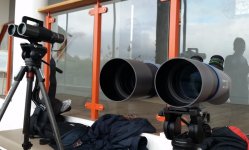Blue72
Well-known member
Big binoculars are not a pipe dream, not sure why that was presented that way. There are many
choices in the realm of quality binoculars in the larger sizes of 15X and higher.
First off I will mention my experience, the cheap astro 15x70 binoculars are just that, cheap,
and often are out of collimation. The Celestron 15x70 Skymaster, should come with instructions
on how to tweak the prism adjusting screws. Those instructions, may be included with purchase.....
Good ones that I have or have had are the Nikon 15x56 and 20x56 Monarch 5 models, they both
deliver a nice view, and tripod mounted of course, for the best use.
The Swarovski 15x56 SLC Neu, Zeiss Conquest HD 15x56, and the Docter Nobilem 15x60 are also great choices.
Your budget will help you in deciding which one is for you. There are many reviews out there, so
no need to explain that here.
Comparing with a spotting scope is natural, and looking with 2 eyes rather than one is a great
advantage for comfort, and ease of view.
Holger Merlitz does post on here, every once in a while. PM him, if you wish and encourage him to post more.
He has his own site, that I look at regularly, he keeps it up, with new reviews, and he has a book that
he wrote a short time ago. When it is printed in English, I will buy one.
Jerry
What’s your opinion of the 15x vs 20x monarch 5






